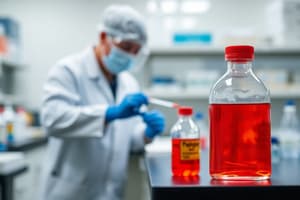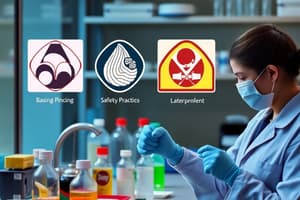Podcast
Questions and Answers
Biosafety is primarily concerned with protecting the environment.
Biosafety is primarily concerned with protecting the environment.
False (B)
Transporting infectious substances does not require strict regulations.
Transporting infectious substances does not require strict regulations.
False (B)
The International Air Transportation Association (IATA) provides guidelines for the shipping of infectious substances.
The International Air Transportation Association (IATA) provides guidelines for the shipping of infectious substances.
True (A)
Laboratories should be selected based on the specimen and analyses required.
Laboratories should be selected based on the specimen and analyses required.
Only international regulations dictate the transport of infectious substances.
Only international regulations dictate the transport of infectious substances.
The primary goal of biosafety is to prevent accidental release of pathogens.
The primary goal of biosafety is to prevent accidental release of pathogens.
Regular amendments to transport regulations do not affect the shipping of infectious substances.
Regular amendments to transport regulations do not affect the shipping of infectious substances.
Failure to comply with packaging and labeling regulations can lead to efficient transport.
Failure to comply with packaging and labeling regulations can lead to efficient transport.
Ebola is classified as a Category A infectious substance.
Ebola is classified as a Category A infectious substance.
The triple packaging system consists of two layers of protection.
The triple packaging system consists of two layers of protection.
When the triple packaging is not available, materials should be packed according to national transportation rules only.
When the triple packaging is not available, materials should be packed according to national transportation rules only.
The outer packaging's smallest overall external dimension must be 15 x 15 cm.
The outer packaging's smallest overall external dimension must be 15 x 15 cm.
Infectious substances in Category B must use a biohazard label.
Infectious substances in Category B must use a biohazard label.
Primary receptacles should not be leak-proof.
Primary receptacles should not be leak-proof.
Severe pathogens classified under Category A are dangerous only in culture.
Severe pathogens classified under Category A are dangerous only in culture.
Absorbent material is not necessary in the secondary receptacle.
Absorbent material is not necessary in the secondary receptacle.
The IATA provides instructions for the proper labeling and marking of packages carrying infectious substances.
The IATA provides instructions for the proper labeling and marking of packages carrying infectious substances.
Secondary packaging must not include any cushioning materials.
Secondary packaging must not include any cushioning materials.
The specimen collection date is optional on a request form.
The specimen collection date is optional on a request form.
Flexible shipping arrangements are only considered under specific international guidelines.
Flexible shipping arrangements are only considered under specific international guidelines.
Haemorrhagic fever agents are included in the Category A list of pathogens.
Haemorrhagic fever agents are included in the Category A list of pathogens.
The World Health Organization is not involved in developing guidelines for sample collection and shipping.
The World Health Organization is not involved in developing guidelines for sample collection and shipping.
Flashcards
Biosafety
Biosafety
A set of rules and practices designed to prevent unintentional exposure to hazardous biological agents, like pathogens and toxins.
Containment principles
Containment principles
The concept of containing hazardous biological agents within a controlled environment.
Biosafety technologies
Biosafety technologies
The use of specific equipment, technologies, and practices to ensure safe handling and study of dangerous biological agents.
Biosafety practices
Biosafety practices
Signup and view all the flashcards
Biosafety levels
Biosafety levels
Signup and view all the flashcards
Disinfection
Disinfection
Signup and view all the flashcards
Transporting infectious substances
Transporting infectious substances
Signup and view all the flashcards
IATA Infectious Substances Shipping Guidelines
IATA Infectious Substances Shipping Guidelines
Signup and view all the flashcards
Triple Packaging
Triple Packaging
Signup and view all the flashcards
Primary Receptacle
Primary Receptacle
Signup and view all the flashcards
Secondary Receptacle
Secondary Receptacle
Signup and view all the flashcards
Outer Packaging
Outer Packaging
Signup and view all the flashcards
Category A Infectious Substances
Category A Infectious Substances
Signup and view all the flashcards
Category B Infectious Substances
Category B Infectious Substances
Signup and view all the flashcards
IATA Packing Instruction 650
IATA Packing Instruction 650
Signup and view all the flashcards
IATA Packing Instruction 602
IATA Packing Instruction 602
Signup and view all the flashcards
Biohazard Label
Biohazard Label
Signup and view all the flashcards
UN 3373 Label
UN 3373 Label
Signup and view all the flashcards
Shipping Category B Infectious Substances in a "602" Package
Shipping Category B Infectious Substances in a "602" Package
Signup and view all the flashcards
Shipping Category A Infectious Substances
Shipping Category A Infectious Substances
Signup and view all the flashcards
Specimen Collection
Specimen Collection
Signup and view all the flashcards
Epidemiological Identification
Epidemiological Identification
Signup and view all the flashcards
Laboratory
Laboratory
Signup and view all the flashcards
Study Notes
Sample Collection and Shipping
- Transport, biosafety, and disinfection are crucial for sample collection and shipping.
- Learning objectives include understanding biosafety principles, pathogen transport methods, biosafety levels in labs, and general disinfection practices.
Laboratory Biosafety
- WHO defines laboratory biosafety as containment principles, technologies, and practices designed to avoid unintentional exposure to pathogens or toxins, or their accidental release.
Principles of Biosafety
- Biosafety principles protect patients, the individual handling the samples, and the surrounding environment.
Air Transport of Infectious Substances
- International Air Transportation Association (IATA) guidelines for infectious substances shipping are used.
- The UN and ICAO have established regulations related to the transport of infectious substances, and IATA guidelines adhere to these standards.
Transport Regulations (1)
- Infectious substances transport is regulated by national and international laws.
- Regulations emphasize proper packaging, labeling, and notification.
Transport Regulations (2)
- Transport regulations are subject to revisions and amendments.
- Regulations necessitate compliance with the most recent national and global requirements.
- Local guidelines supersede international guidelines where applicable.
How to Select a Laboratory
- Laboratory selection depends on the specimen type, required analysis, and lab capabilities.
- Evaluate lab capacity before sample shipment.
- Analyze specimen type, consider specific laboratory requirements (e.g., Ebola diagnosis).
- Identify recipient and relevant lab before shipment.
- Consider available transportation options and the timing of the process.
- Factor in the capacity of various lab options ( national reference labs, WHO collaborating centres, hospital labs, network labs).
What to Include on a Request Form
- Specimen collection date and time are necessary.
- Epidemiological data ( patient identifiers, age, sex, etc.) to help link laboratory and epidemiological data.
- Details of suspected clinical diagnoses and major symptoms.
- Contextual information about potential outbreaks or routine surveillance is needed.
- Sender's name(s) and contact information.
Triple Packaging
- Triple packaging is important to protect the environment, the carrying material, and the specimen itself.
- It protects goods during transport while adhering to international dangerous goods transport rules, and guidelines provided by the IATA.
The Basic Triple Packaging System
- Three layers of protection ensure safe specimen transport: primary receptacle, secondary packaging, and outer packaging.
- IATA guidelines specify details about packaging requirements, markings, labeling, documentation, and proper refrigerant usage.
The Basic Triple Packaging System: Primary Receptacle
- Leak-proof, specimen containers.
- Sufficient absorbent material to absorb the entire primary receptacle content.
The Basic Triple Packaging System: Secondary Receptacle
- Leak-proof secondary containers.
- Encloses and protects the primary receptacle(s).
- May contain multiple cushioned primary receptacles.
The Basic Triple Packaging System: Outer Packaging
- Outer packaging cushions secondary packaging to protect it from damage during transit.
- Outer packaging should have a small enough overall dimension, e.g. dimensions of 10cm by 10cm
Infectious Substances Included in Category A
- Highly pathogenic microorganisms.
- List of these microorganisms is available.
- This includes Haemorrhagic fever agents and Variola virus.
- Also, includes other pathogens dangerous only in culture (important for lab personnel).
Key Principles: Dangerous Goods
- Infectious materials are classified as Category B and A.
- Different packaging and marking specifications are applicable to each category.
- Category B Infectious substances can be shipped inside a “602” package provided labelling and marking comply with standards.
- Category A Infectious substances are not permitted in a "650" package.
Category A
- A list of specific infectious biological substances is given, and each can only be sent as a culture.
Studying That Suits You
Use AI to generate personalized quizzes and flashcards to suit your learning preferences.




